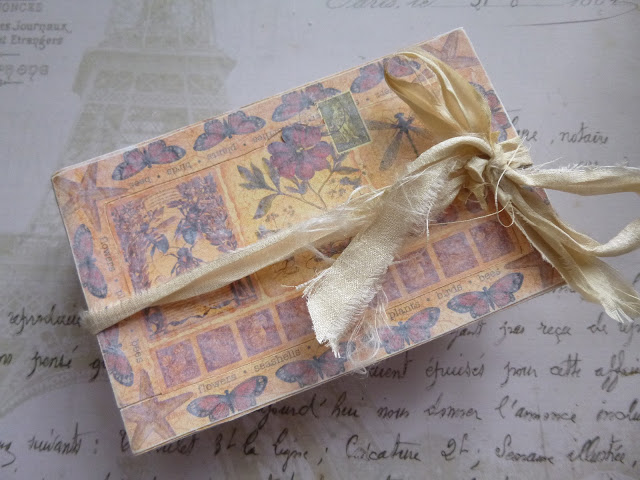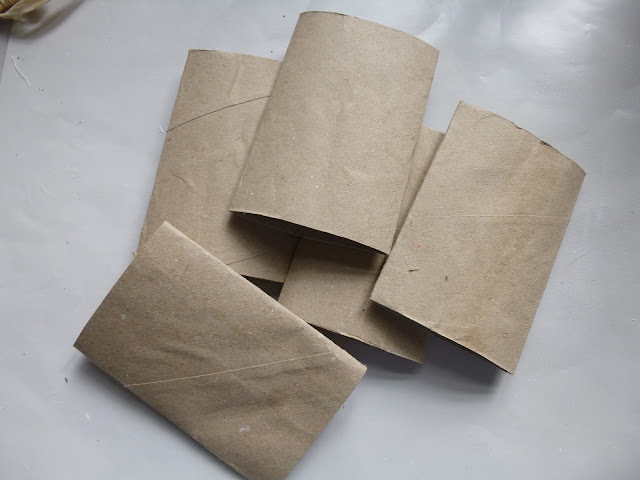Some time very early in my crafting journey I saw a mini album made from leftover toilet rolls, and since then I've made a number of them in various styles. It always makes me happy as I see something so mundane being transformed into a fabulous little book.
I've given a few measurements in places, just so you have a general idea, but it will vary according to the size of your toilet rolls - believe it or not, they're not all the same - so none of this is set in stone. And I'm always more of a "by eye" crafter than a millimetre-perfect one. The imperfections are part of the fun for me.
So you start by saving up your toilet rolls - five or so is a good number - and simply press them flat.
I then usually paint the ends and edges and just inside the "pockets" so that there won't be any grey cardboard showing later on. It's just easier to do this now than later.
Once they're dry, it's a good idea to give them another pressing with a weight of some kind.
Some gentle scoring allows me to make the folds and voila - we have the structure. Now we can start to decorate it.
The papers I'm using are from the Graphic 45 Botanicabella set. I started by covering the covers front and back (interior and exterior really).
At first I was planning to stick with the crackle design for the front cover and embellish it somehow...
If you don't mind having different papers facing each other, you can relax for a bit longer. I've made albums both ways, but for this one I'm going for the double page spread, so I need to keep my pages in the right order from here on.
Once you have one cut to size, you can use it as a template for the rest.
I think it's nice to have the inserts showing a little way outside the pockets - that's why I made the exterior covers that bit wider. But you can also choose to have them tucked a bit further away, and use metal tabs to get hold of them.
You need one strip each end to glue to the cover wall, so don't forget to leave enough for that. That means for my five pages I need seven slots in total. So if you've got four pages, you'll need six slots; or you'll need eight slots for six pages etc.
Add glue to each end strip and plenty in the spine of the cover and press the concertina into place. You can adjust a bit to make sure the slots are evenly spaced and then apply pressure while the glue dries.
I sanded all the edges - pages, covers and inserts - and at this point I would usually ink everything up. But I decided I rather liked the white edging...
... so much so, in fact, that I decided to go for more white-washed look overall.
So then everything got a wash of white acrylic for a more shabby-chic effect. I really like how this just softens the look quite subtly.
Then glue the ends of the pages in place, and hold them until you can feel they are firmly attached.
And there you have it - all your pages ready for adding photos, memorabilia, quotes, notes, even some stamping if you want.
For now it's not glued on, as I might want to add some more embellishing but, when I do, I'll glue it at the spine but not across the front cover.
That way, when you undo it you will still see the full glory of the papers.
The opening page is single-sided, facing the inner cover.
And each tab contrasts with its page, but matches the tab opposite.
It's only the front and back covers where you have different papers on each side.
But that shows how it looks if you choose to vary papers on every side.
You can add journalling panels and cards to the pockets too, there's plenty of room.\
But I think this tutorial is plenty long enough already, so I'm going to leave it at this stage...
If you want to check out a few more of my examples, take a look at the links below, but you'll also find them all over YouTube and on many craft blogs.
Thanks so much for joining me today, and we hope you'll come and play along in our November challenge. Any handmade book goes, and you could win a fabulous prize from this month's sponsor Lindy's Stamp Gang.
Alison x
Words and Pictures














































